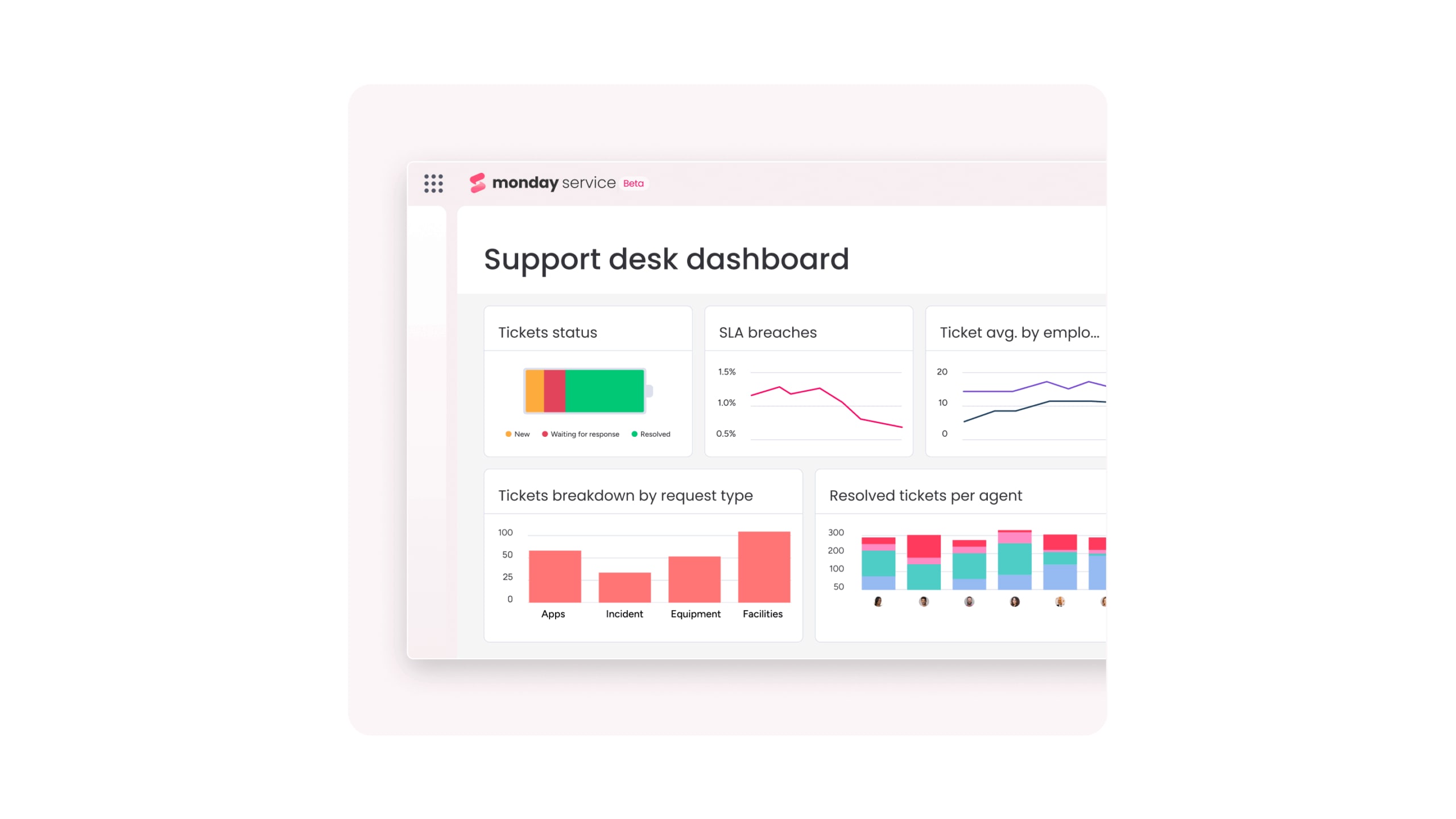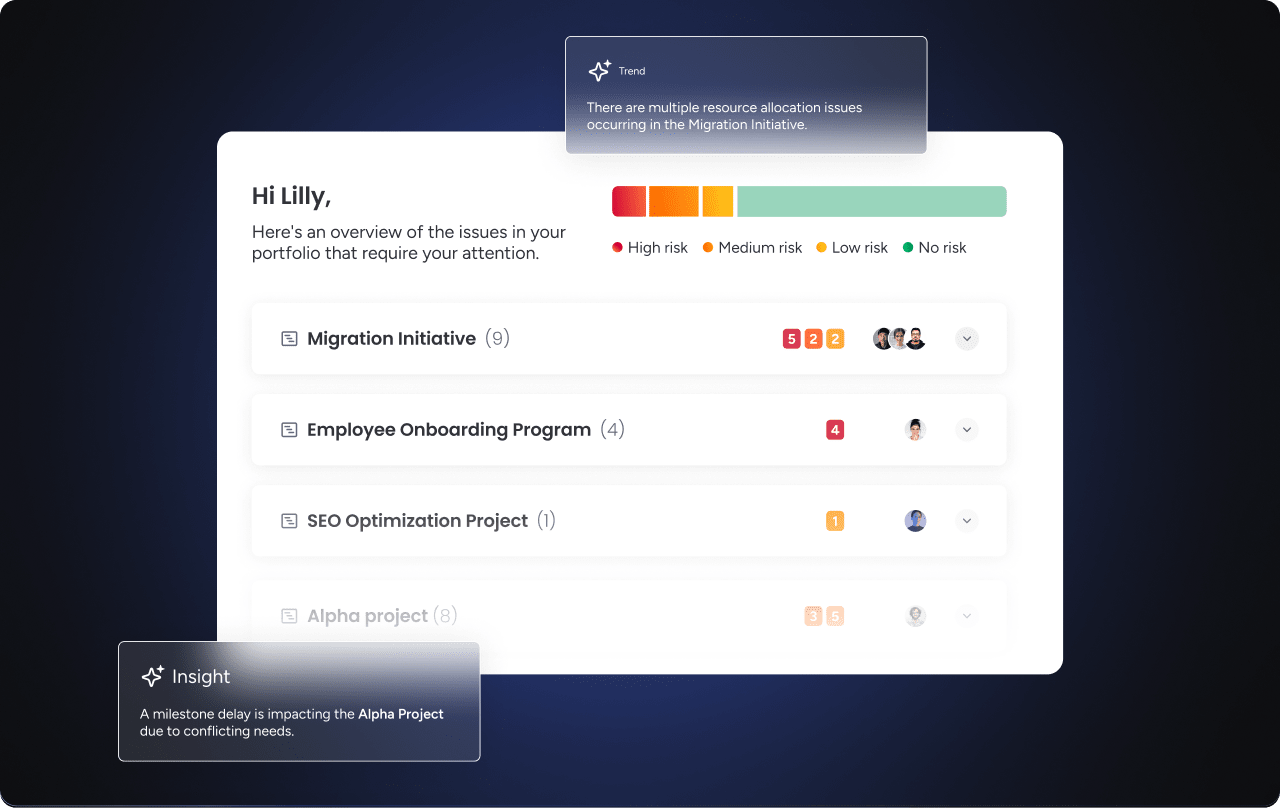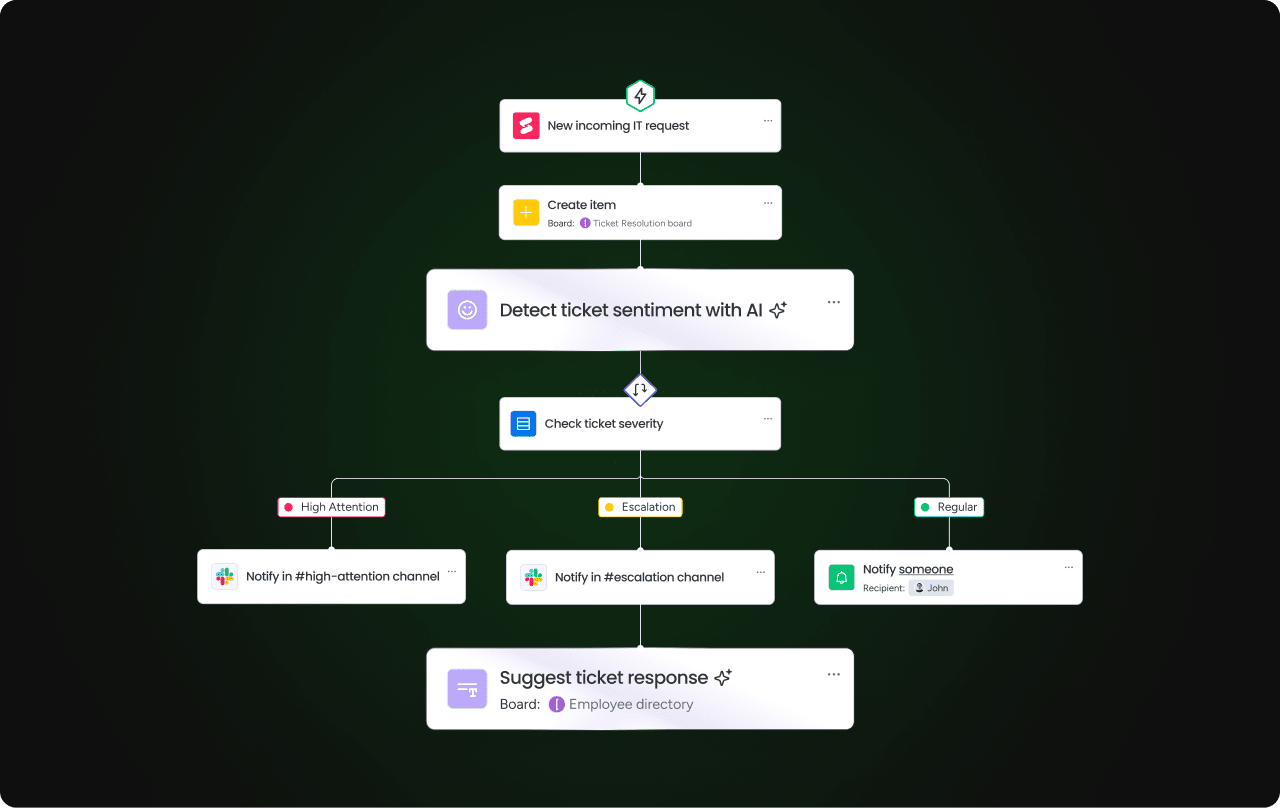Facility teams are under more pressure than ever: larger portfolios, more interconnected systems, and higher service expectations. Even as demands increase, many teams continue to work with outdated tools and siloed data, which slows them down.
Whether it’s a missed hazard or a delayed HVAC fix, reactive operations come with real costs.
AI offers a new path forward. From predicting equipment failures to optimizing energy use and routing service tickets, AI gives facility managers better control, faster insights, and fewer surprises.
In this article, we’ll explore how AI, automation, and facilities management software like monday service can help facilities teams modernize operations, reduce downtime, and gain visibility into every moving part.
What is AI in facilities management?
AI in facilities management refers to the use of intelligent systems, like machine learning, data models, and automation, to monitor, maintain, and optimize facilities. These tools help monitor equipment, flag inefficiencies, automate ticket handling, and improve service decisions.
Unlike manual processes or fixed schedules, AI-enabled platforms can recognize usage patterns, predict equipment issues, and automate repetitive service tasks. That shift allows teams to focus on strategic decisions and deliver faster support without constantly reacting to emergencies.
You may encounter terms such as “automated facility management systems” or “intelligent building platforms.” These fall under the broader category of AI-powered operations, where data from sensors, systems, and teams is connected into smarter decision-making flows.
Where is AI currently used in facilities?
AI is transforming day-to-day facilities operations with practical use cases that enhance operational efficiency, reduce costs, and support long-term sustainability goals. Common applications span the entire facility lifecycle, including:
- Predictive maintenance: Machine learning models analyze real-time data, like vibration, pressure, or temperature, from critical assets to detect early signs of failure. This supports condition-based maintenance that prevents disruptions, lowers downtime, and contributes to both cost savings and operational efficiency.
- HVAC and energy optimization: AI dynamically adjusts HVAC systems based on occupancy patterns, weather conditions, and the time of day. This decreases energy waste without sacrificing comfort. By continuously optimizing energy consumption, teams enhance energy efficiency and move closer to achieving their sustainability goals.
- AI-enhanced security systems: AI-powered video analytics and access controls automate threat detection and alerts. That reduces reliance on manual monitoring while improving safety across large facilities or high-security zones.
- Digital twins for live modeling: AI combines data from sensors, building systems, and blueprints to support digital twins that accurately mirror building conditions in real-time. These models help teams test layout changes, simulate upgrades, or identify energy consumption inefficiencies before taking action.
- Occupancy and space planning: Sensors paired with AI provide continuous insights into how rooms and zones are used. This supports more accurate space utilization, cleaning schedules, and layout decisions, leading to optimized space utilization and enhanced overall operational efficiency.
- Inventory and spare parts management: AI tracks usage trends and predicts future demand, automating reorders and reducing costly downtime. This means the right parts are available when needed without tying up budget in unnecessary inventory.
- Energy and systems anomaly detection: AI learns your facility’s baseline behavior and flags irregularities, such as energy consumption spikes or erratic system cycling. This early detection prevents waste, boosts system health, and contributes to energy efficiency initiatives.
- Service ticket classification and routing: Natural language processing and pattern recognition automatically analyze incoming service requests, categorize them, and route them to the right technician. This lowers response time and enhances the quality of service delivery.
- Maintenance scheduling and escalation: AI uses live data to generate smart schedules for repairs and inspections. It also escalates requests when service delays risk breaching service level agreements (SLAs) or impact essential infrastructure, helping teams maintain uptime and avoid service disruptions.
Want to learn more about how to deliver better service? Learn how to deliver better service at scale with automated quality management.
Benefits of AI-powered facilities management systems
AI enhances, helps, and enables facilities teams to work smarter, faster, and more strategically. By integrating intelligent systems into everyday workflows, teams can reduce manual overhead, raise uptime, and optimize resources at scale.
Here are some high-impact benefits organizations are seeing today:
Faster service resolution with intelligent triage
AI-powered systems can automatically classify, prioritize, and route service requests as they come in. Instead of relying on manual review or team bandwidth, requests are instantly sent to the right technician or vendor, based on issue type, urgency, location, or historical context. This decreases delays, prevents missed maintenance, and maintains consistent resources, even during volume spikes or after-hours incidents.
Proactive maintenance that prevents costly downtime
AI-powered predictive maintenance helps facilities teams shift from reactive service to condition-based care. By analyzing sensor inputs, such as temperature changes, pressure variations, or unusual vibration patterns, AI can detect early signs of equipment stress or impending failure.
This proactive approach reduces emergency work, minimizes disruptions, and extends asset life. According to a 2024 report on downtime from Siemens, organizations using predictive maintenance tools saw:
- Up to 50% reduction in equipment downtime
- 40% decrease in maintenance planning time
- 20-25% improvement in asset availability
These gains directly support higher productivity, better resource allocation, and fewer costly surprises.
Lower operating costs through intelligent automation
AI continuously monitors building conditions, factoring in occupancy patterns, weather data, and time-of-day trends, to optimize energy use across HVAC systems, lighting, and ventilation.
Instead of relying on fixed schedules or manual inputs, smart automation dynamically adjusts systems, reducing energy consumption without compromising comfort or safety. According to findings in a 2024 Siemens report, facilities using AI-driven controls achieved:
- Up to 25% reduction in energy costs
- 30% improvement in overall building efficiency
These efficiencies add up to major cost savings while helping teams advance sustainability goals and improve operational efficiency across sites.
Streamlined collaboration across departments and vendors
AI helps eliminate the bottlenecks that come from siloed systems or unclear ownership. When a ticket is submitted, the platform can loop in all relevant parties, facilities, IT, security, or external vendors, and provide access to equipment history, service notes, or compliance records.
That shared visibility minimizes back-and-forth, decreases rework, and accelerates resolution times across teams.
Smarter workforce and inventory planning
AI tools analyze technician availability, location, and skill set to match the right person to the right task, reducing idle time and improving first-time fix rates.
It also monitors inventory trends, forecasts future parts demand, and automates reordering based on usage patterns.
This ensures that high-priority jobs don’t get delayed due to missing parts, and that teams aren’t overstocking items that rarely get used.
Want to learn more about how to use AI to manage your inventory? Check out AI inventory management: Hit higher profits with smarter stock control.
Real-time insights and performance tracking
AI powers live dashboards and alert systems that monitor KPIs like request volume, average resolution time, energy usage, and SLA compliance.
These insights enable teams to identify bottlenecks, allocate resources proactively, and effectively demonstrate service performance to stakeholders.
For enterprise-scale operations, this level of transparency is key to scaling efficiently while maintaining accountability and service quality.
How to use AI and real-time data in smart facilities
Modern facilities generate a constant stream of data, ranging from HVAC sensors and access logs to service tickets and asset usage records. AI turns that data into action.
With tools like digital twins and IoT integrations, teams can monitor conditions in real time and test changes virtually before making decisions.
Whether you’re adjusting airflow based on occupancy or planning renovations, AI provides a clearer view of what’s happening and what to do next.
IoT sensor integrations
Smart sensors placed throughout buildings collect live data on occupancy, air quality, temperature, energy use, and system health. AI systems interpret that data to:
- Recommend cleaning schedules based on foot traffic
- Adjust the airflow in lightly used areas
- Flag outlier performance on compressors or chillers
As connected infrastructure expands, AI can coordinate these systems across multiple buildings or campuses, creating a single view of performance for distributed teams.
That shared intelligence transforms siloed equipment into a unified, responsive network, enabling teams to anticipate needs instead of reacting to them.
Space and energy optimization
AI provides facilities teams with a clearer picture of how space is actually used, revealing underutilized rooms, inefficient layouts, and zones that are being overconditioned. By analyzing occupancy patterns and system data, AI enables teams to make more informed decisions that drive both cost savings and operational efficiency.
That insight powers smarter decisions, like:
- Scaling back HVAC in unused spaces
- Reassigning rooms based on actual demand
- Redesigning layouts to optimize energy flow and foot traffic
These optimizations reduce energy consumption, enhance space utilization, and support sustainability goals, while creating a more comfortable and productive environment for employees and visitors alike.
Priorities may vary by industry. Healthcare facilities might emphasize HVAC performance and compliance tracking, while corporate offices focus on space planning and hybrid work models. Aligning AI efforts with your facility’s goals and risk profile ensures the most valuable impact.
Continuous monitoring
AI continuously scans system data for anything out of the ordinary, such as spikes in water usage, motors cycling too frequently, or power consumption surges. When something deviates from the expected pattern, it flags it for review.
This kind of intelligent monitoring helps teams catch:
- Leaks before they cause damage
- Energy spikes before billing surprises hit
- Wear patterns before equipment failure
With instant alerts and automated escalations, facilities teams stay ahead of problems instead of reacting after the fact.
Generative and multimodal AI for strategic facility operations
As AI matures, facilities teams are shifting focus from daily operations to long-term strategy. Generative and multimodal AI represent the next frontier, enabling leaders to simulate outcomes, optimize budgets, and future-proof their spaces with confidence.
These tools go beyond basic automation. With generative and multimodal models, facility leaders can forecast outcomes, test budget scenarios, and plan smarter for evolving needs.
Use generative AI to:
- Evaluate the cost-benefit of replacing vs. repairing assets
- Project long-term energy or staffing needs
- Adjust investment plans as real-world conditions shift
Multimodal AI combines inputs such as visuals, blueprints, logs, and sensor data to power dynamic digital twins that adapt to changing conditions. That means smarter decisions with less guesswork.
Scenario planning with generative AI
Generative models allow teams to test assumptions and explore different paths before committing resources. Whether assessing lease renewals, equipment upgrades, or vendor changes, AI-powered simulation tools generate a clearer picture of long-term impact.
Facility leaders can:
- Compare the ROI of replacing aging assets versus extending service contracts
- Forecast energy costs, maintenance needs, and labor requirements across different scenarios
- Adjust plans as conditions change, without relying on static spreadsheets or manual models
That means better budgeting, more confident investment planning, and stronger operational resilience.
Multimodal data and digital twins
Multimodal AI integrates structured and unstructured data, like visuals, blueprints, sensor feeds, and log files, into a unified view of a building’s environment. That foundation enables digital twins that reflect real conditions and support day-to-day decisions.
Teams can use digital twins to:
- Test space reconfigurations or system upgrades virtually before making changes
- Run safety or emergency simulations using up-to-date occupancy and system data
- Monitor performance trends across HVAC, lighting, or access control systems
With this kind of continuous modeling, facility managers don’t have to guess what’s working. They can see it, test it, and adjust accordingly.
How monday service supports AI-driven facility operations
AI delivers the most value when it’s tightly integrated into the systems teams use every day. With monday service, teams can bridge intelligent functionality with real-world service management, connecting data, processes, and people across the organization.
Whether managing incoming requests, scheduling work, or reviewing past performance, teams can use monday service to eliminate bottlenecks and move faster with less overhead. And with AI deeply embedded into ticketing, automation, and workflows, they can scale service delivery without scaling headcount.
Manage tickets and facility data with advanced AI
With AI Blocks, facilities teams can streamline tasks that previously required manual triage or review. Instead of wading through dozens of requests, teams can focus on what needs attention now.
Here’s how it works:
- Categorize new requests by keyword, urgency, or sentiment using the Assign labels AI Block.
- Extract info from maintenance logs, images, PDFs, or notes using the Extract Info AI Block.
- Summarize ticket history with the Summarize AI Block so responders get full context at a glance.
- Detect sentiment in tenant or employee feedback to spot frustration and prioritize faster.
- Automatically route and escalate based on building, issue type, or severity using Automated Workflows.
These AI capabilities decrease manual triage and response lag, while freeing agents to focus on more strategic work.
Connect teams, tools, and timelines in one platform

Facilities work rarely happens in a vacuum. Whether it’s IT, security, or external vendors, resolving issues requires collaboration and visibility across teams.
With monday service, you can:
- Link requests to project timelines, vendor SLAs, or inspection records
- Sync with other platforms, like CRM, HR, or asset management, for a complete operational picture
- Coordinate across departments without losing track of updates or ownership
- Maintain a complete request log for trend analysis, SLA reporting, and audits.
This kind of visibility helps organizations align efforts and avoid repeated triage across disconnected systems.
Reduce delays and missed steps with automation
With monday service, workflow automations, and AI-powered Digital Workers, limit repetitive work and help teams deliver consistently.
Examples include:
- Escalating unresolved requests that exceed time thresholds, flagged proactively by a Digital Worker
- Sending surveys or progress updates automatically
- Scheduling inspections, safety checks, or recurring services
- Assigning tasks based on building type, system category, or floor plan
- Using platform integrations, like Slack, Outlook, or Azure DevOps, for smooth handoffs

These automations keep service operations running smoothly and ensure that nothing slips through the cracks.
How to implement AI in your facilities management workflows

AI adoption doesn’t have to be overwhelming. Start where the friction is highest, align your teams early, and choose tools that can scale with you. Whether you’re introducing automation or expanding existing service flows, clear priorities and collaboration will accelerate results.
Start with your biggest service bottlenecks
Look for areas where delays or inconsistencies are holding your team back, such as missed tickets, unplanned outages, or slow approvals.
Start by mapping out what happens today. Identify where time is lost, handoffs break down, or information gets buried. Then, explore where intelligent automation could step in:
- Auto-routing tickets based on category or severity
- Assigning maintenance based on technician location or availability
- Scheduling recurring tasks dynamically instead of manually
Bring your service desk and facilities teams in early. Their frontline insights are key to designing practical solutions, not just ideal ones.
Tip: Begin with a focused pilot, such as triaging HVAC requests, and then expand once results are measurable.
Unify your systems to avoid fragmented automation
Disconnected tools slow down service and obscure visibility. Even if each system is effective on its own, they often don’t scale well together.
A unified platform provides your teams with a single location to track service requests, vendor activity, and asset performance, resulting in less manual coordination.
With connected systems, like CRM, asset tools, and ticketing, you can:
- Eliminate double entry across systems
- Monitor performance trends in real time
- Collaborate across departments without relying on email updates
That means fewer silos, faster handoffs, and more reliable operations.
Track the right metrics after implementation
Once AI is embedded into facility operations, it’s important to track its performance against business goals. Here are the KPIs (key performance indicators) that matter most:
- Time-to-resolution: Measure how much faster tickets are being closed post-automation or AI classification.
- SLA compliance rate: Track whether automated workflows are helping your team meet service-level targets.
- First-touch resolution: Use ticket data to measure the effectiveness of routing requests without requiring escalation.
- CSAT scores: Analyze survey feedback to spot where AI-enhanced workflows are improving satisfaction.
- Technician workload distribution: Monitor whether AI-based task assignments are balancing load across the team.
- Recurring issue rate: Fewer repeat requests indicate that AI is improving root-cause visibility and implementing long-term fixes.
The dashboards in monday service provide real-time visibility into all of these metrics, helping teams iterate and improve.
Connect your existing tools and data sources
Your teams already rely on tools like Outlook, Slack, Azure DevOps, and DocuSign. Integrate them directly into your platform to lower tool-switching and keep updates flowing.
You can also pull in data from:
- IoT sensors (e.g., temperature, motion, energy)
- Vendor platforms for contract SLAs or repair history
- Project dashboards or Gantt charts for cross-functional planning
When all your systems feed into one source of truth, your team spends less time chasing data and more time acting on it.
Protect data with strong privacy and governance
AI in facilities often handles sensitive information, including vendor contracts, employee records, and building access logs. monday service is designed with enterprise-grade security and governance in mind.
Capabilities include:
- Role-based access controls to restrict sensitive data by user type
- Audit trails to maintain accountability for changes and automations
- Model transparency so admins can review how AI decisions are made
- Compliance with industry standards like SOC 2, ISO 27001, and more
Teams can also configure how AI Blocks and Digital Workers interact with internal data, ensuring alignment with IT, legal, and compliance teams.
Common barriers to implementing AI in facility operations
AI adoption promises significant returns, but also comes with practical challenges. Here are a few common barriers facility teams should plan for:
- Siloed data and systems: Without unified platforms, it’s hard to train accurate models or automate across teams. Integration with tools such as CRMs, asset managers, and IoT sensors is crucial.
- Lack of clear ownership: If it’s unclear who owns service workflows or data sources, AI initiatives can stall. Success requires shared accountability between facilities, IT, and service teams.
- Fear of job displacement: Some teams may view automation as a threat to jobs. Framing AI as a way to limit grunt work, rather than replace people, is crucial to gaining buy-in.
- Data quality issues: Outdated records, inconsistent tags, or missing history make automation less reliable. Start by cleaning your data where it matters most.
- Budget or time constraints: Long implementations hurt momentum. With monday service, teams get started quickly with no-code tools, templates, and intuitive interfaces.
Avoid these pitfalls by starting small, aligning cross-functional teams, and closely tracking outcomes. Start with one high-friction workflow, such as ticket triage or recurring maintenance, and build upon it from there.
Trends for AI in facility management
AI is no longer experimental — it’s becoming foundational. As adoption accelerates, here are key trends shaping the future of AI in facility management:
- Digital workers: These are AI-powered agents that continuously monitor systems, flag issues, escalate requests, and track resolution progress. They decrease the burden on human teams and help maintain 24/7 operational continuity.
- Generative modeling: This trend involves using AI to simulate different scenarios, such as budgeting, staffing, or capacity planning. It helps facility leaders make more confident, data-driven decisions in complex environments.
- Standardized digital twins: These are real-time, continuously updated models of physical spaces that reflect live conditions across building systems. As digital twins become standardized, they will support both day-to-day operations and long-term strategic planning.
- AI-powered sustainability insights: As regulations evolve, AI will play a growing role in tracking emissions, reducing energy waste, and producing ESG reports. This supports both environmental goals and long-term cost control.
With AI-ready platforms, you can build, adapt, and scale your service model faster, without reinventing the process each time.
Unlock smarter, faster facility operations with AI
Facility teams are expected to deliver more across more buildings, systems, and stakeholders without increasing headcount or overhead. AI helps you meet those demands by reducing downtime, improving service speed, and making every decision more strategic.
With monday service, you get a platform built for modern facility operations.
Automate workflows, optimize resource allocation, and gain real-time visibility across buildings, vendors, and teams—all in one place.
See how monday service can streamline your operations.
Try monday serviceFAQs
What is the best facility management software?
The best facility management software is one that combines service request handling, asset tracking, automation, and data-driven insights. Tools like monday service offer integrated workflows, predictive maintenance features, and AI-powered automation to help facility teams scale operations efficiently.
What is an automated facility management system?
An automated facility management system uses software and AI tools to streamline core operations such as ticket routing, maintenance scheduling, asset monitoring, and vendor coordination. These systems reduce manual work and help teams respond faster, optimize costs, and maintain compliance more easily.
What is the CAFM system?
A CAFM (computer-aided facility management) system helps organizations manage physical spaces, assets, maintenance tasks, and service operations. Many modern CAFM systems incorporate AI to support predictive maintenance, energy optimization, and real-time monitoring.
What is an example of CAFM?
An example of a CAFM system is a platform that tracks HVAC performance, schedules preventative maintenance, and manages service requests across multiple facilities—all through a centralized dashboard.
What is the difference between CAFM and CMMS?
CAFM systems support a broader range of tasks, including space planning, compliance tracking, and asset management. CMMS (computerized maintenance management systems) are more focused on scheduling and tracking maintenance activities. Today, many platforms combine both and enhance them with AI for smarter automation and forecasting.
 Get started
Get started


